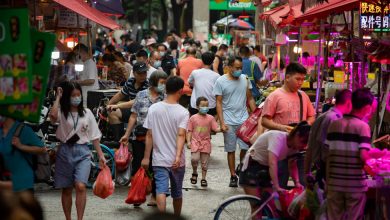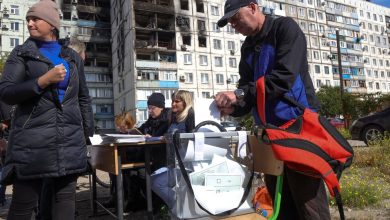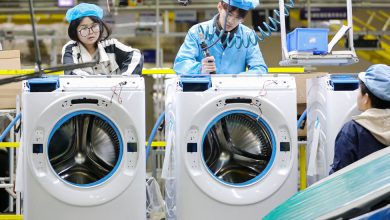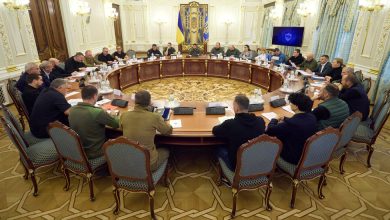Ukrainian Children With Cancer Fight Their Own War Within a War
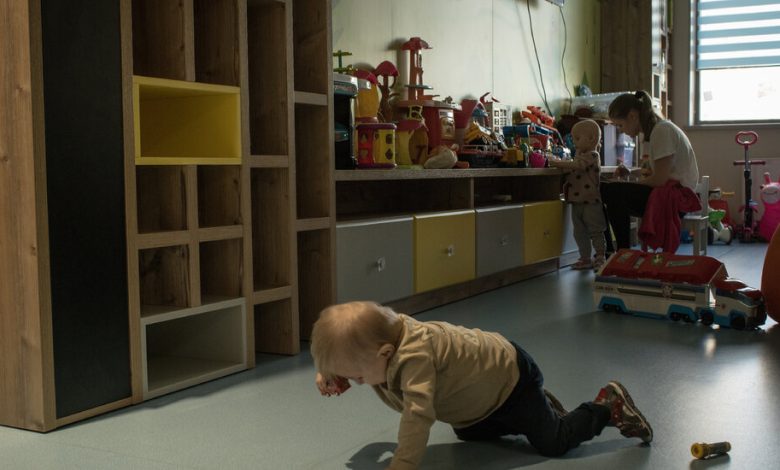
Eighteen-month-old Mykola clutched his mother’s finger as he toddled up the hallway of the national children’s hospital in Kyiv, his still-unsteady legs eager to keep up with his desire to walk.
Mykola has spent the entirety of his short life in the hospital. His cancer was diagnosedat birth, just a month before Russian forces invaded Ukraine.
“It’s like you have two wars to fight,” said his mother, Anna Kolesnikova. “Two wars in your life: one is to save your child’s life, and the other war is for your country.”
Across Ukraine, families of children with cancer are facing the dual agonies of life-threatening illness and a country engulfed by war. For many, the Russian invasion has meant displacement from their homes, fear of airstrikes and separation from loved ones, including family members serving in the military.
But despite the new hardships, the conflict has also contributed to development in Ukrainian pediatric oncology, experts say, thanks to greater cooperation with international partners at this moment of crisis.
Still, for families like the Kolesnikovs, the war has only compounded their pain.
Mykola was born in Kherson in January 2022 with a malignant tumor that distorted his face and neck and left him with just one functioning eye. He was sent to Ohmatdyt Children’s Hospital in Kyiv almost immediately for chemotherapy and surgery.
He and his mother spent weeks sheltering in the hospital’s basement so that Mykola could continue treatment even as Kyiv came under attack.
Their hometown in the Kherson region of southern Ukraine was soon seized by Russian forces and remains under occupation. Ms. Kolesnikova, 32, has stayed in Kyiv with Mykola, while her husband, her older son and her parents remain on the other side of the front lines, which can seem like the other side of the world.
“I am separated from my family,” she said. “And I am constantly worried for my kid’s life and for the lives of my parents and my other son.”
She feared the worst when the Nova Kakhovka dam was destroyed last month, flooding part of the Kherson region, but her family was unharmed.
At the start of the war, many children with cancer were hastily evacuated to other European nations, or farther afield. The evacuations, coordinated with SAFER Ukraine in partnership with St. Jude Global, ensured their treatment could continue uninterrupted.
“We had a lot of attention to save this big, vulnerable group of children,” said Dr. Roman Kizyma, a pediatric oncologist and the acting director of Western Ukrainian Specialized Children’s Medical Center.
Since then, Ukraine’s approach to pediatric cancer care has shifted, said Dr. Kizyma, 39. Starting last summer, the focus has been on capacity-building within the country. While some children with complex needs are still sent abroad, most now remain in Ukraine.
With new coordination with international partners, growing links with European hospitals, new training opportunities, and more experts providing aid in the country, Dr. Kizyma said he hoped to see pediatric oncology strengthened in Ukraine.
“I think that the level is going up, and maybe it will be even higher,” as a result of the war, he said, pointing to more specialized treatments in regional hospitals since the war began.
Many childhood cancers are treatable, but the prospects depend on where a child receives care. In the wealthiest countries, with greater access to treatments and medicines, more than 80 percent of children with cancer survive at least five years. In poor and middle-income countries, the rates can be lower than 30 percent, according to the World Health Organization.
Yulia Nogovitsyna, the program director for Tabletochki, the leading Ukrainian pediatric cancer charity, said that they estimate that around 60 percent of children in the country are successfully treated.
“There is still a gap between Ukraine and high-income countries, and you want to bridge this gap,” she said.
Tabletochki, which is funded by international donors including Choose Love, provides assistance like housing, medicine and psychological support for children with cancer and their families, as well as palliative care support, and also buys equipment and medicine and provides training for health care workers.
There have been some hopeful signs even amid the war, Ms. Nogovitsyna said, with an increase in practitioners being trained abroad.
“Education and training can change things more than just renovation and more than medicines,” she said.
But there are new challenges as well. The charity has long relied on crowdfunding donations, but has struggled to raise money within Ukraine during the war, and is seeing higher levels of poverty among families it supports.
And it can no longer reach children in Russian-occupied areas.
“This is the worst thing, because some of the children, they are in palliative status, so they are dying,” she said, and need morphine or other crucial painkillers. “There, we cannot do this. So, children are just dying with pain, and this is very tragic.”
For some children, the war also delayed diagnosis and treatment.
Sasha Batanov, 12, was in a hospital in Kharkiv, bedridden with severe back pain, in February 2022 when the Russian invasion began and the hospital was evacuated. He was takenhome, and sheltered there for weeks.
“I was trying to calm him down,” his mother, Nataliia Batanova, said. “Although I realized something was going on.”
They didn’t know it yet, but Sasha had leukemia. If he could have stayed in the hospital, it would have been caught sooner, his mother said.
It would be July before the cancer was diagnosed and he was transferred to Kyiv for chemotherapy. Sasha also needed a bone-marrow transplant, which he received this April.
For now, Sasha, his mother and his brother are living in an apartment in Kyiv while he continues treatment. His father is a soldier, fighting in the country’s east, adding to their fears. But Ms. Batanova has hope.
“We are happy that we have this life today, this very moment,” she said. “This is what the war and this life taught us.”
For children with cancer and their families, it can be a struggle to find even a small piece of normalcy as personal and national crises converge.
Viktoria and Serhiy Yamborko hoped that a summer camp in the Carpathian Mountains of western Ukraine earlier this month would give them time to create some happy memories with their 5-year-old daughter, Varvara, whose cancer was diagnosed last year.
They traveled there with Tabletochki, which runs camps for children and their families to swim, hike, and relax.
With nervous excitement, Varvara, wearing a small riding cap, was helped onto the back of a horse for a trail ride, the pine forests stretching out in the valley below. Mr. Yamborko, 50, took a video on his phone while Ms. Yamborko, 38, held her daughter’s arm.
“These rehabilitation moments, although they are few, they help you go on,” said Mr. Yamborko, who said they had also relied on their deep Orthodox faith to sustain them.
The family is originally from Kherson, but was in Kyiv at the start of the war and fled to the relative safety of western Ukraine for a few months. That was when they noticed changes in Varvara, who fractured three bones in a short time and grew increasingly unwell.
Last summer, when they returned to Kyiv, they got the diagnosis they feared.
“It felt like the end of the world,” Ms. Yamborko said, describing her difficulty in coping with the news, while also fearing for family still living in Kherson. “I thought that was it.”
Varvara endured months of intensive chemotherapy and other treatments, and was discharged from the hospital this summer. She continues to receive outpatient care, but her energy and feisty spirit have returned, her parents said.
With a lilac baseball cap covering her short hair that has begun to grow back, Varvara said excitedly that her favorite part of the camp was spending time with the other children.
“It’s great to be around the other parents, you don’t have to explain everything,” said Ms. Yamborko. “Here, we understand each other without words.”
Even for children in remission, like Anna Viunikova, the war has complicated ongoing care. Anna, 10, received a bone-marrow transplant and chemotherapy for leukemia before the war, and her dark auburn hair had grown back.
But the war shattered her family’s attempts to resume normal life. Russians occupied their village in the Kherson region. Her mother feared for their safety, and for Anna’s ability to get regular checkups, so last summer, Anna and her parents fled to Kyiv.
“I want everything to be good,” Anna said. “So that I could just sit and eat watermelon. To be able to walk and ride a bike, like it was before. But it won’t be like it was.”
Oleksandr Chubko and Daria Mitiuk contributed reporting.

